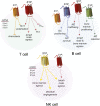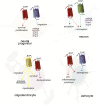An update on the biology of sphingosine 1-phosphate receptors
- PMID: 24459205
- PMCID: PMC4109755
- DOI: 10.1194/jlr.R046300
An update on the biology of sphingosine 1-phosphate receptors
Abstract
Sphingosine 1-phosphate (S1P) is a membrane-derived lysophospholipid that acts primarily as an ex-tracellular signaling molecule. Signals initiated by S1P are transduced by five G protein-coupled receptors, named S1P1-5 Cellular and temporal expression of the S1P receptors (S1PRs) determine their specific roles in various organ systems, but they are particularly critical for regulation of the cardiovascular, immune, and nervous systems, with the most well-known contributions of S1PR signaling being modulation of vascular barrier function, vascular tone, and regulation of lymphocyte trafficking. However, our knowledge of S1PR biology is rapidly increasing as they become attractive therapeutic targets in several diseases, such as chronic inflammatory pathologies, autoimmunity, and cancer. Understanding how the S1PRs regulate interactions between biological systems will allow for greater efficacy in this novel therapeutic strategy as well as characterization of complex physiological networks. Because of the rapidly expanding body of research, this review will focus on the most recent advances in S1PRs.
Keywords: activation; endothelium; immune cells; immunity; migration; nervous system; vascular permeability.
Copyright © 2014 by the American Society for Biochemistry and Molecular Biology, Inc.
Figures





References
-
- Schwab S. R., Pereira J. P., Matloubian M., Xu Y., Huang Y., Cyster J. G. 2005. Lymphocyte sequestration through S1P lyase inhibition and disruption of S1P gradients. Science. 309: 1735–1739. - PubMed
-
- Schmelz E. M., Crall K. J., Larocque R., Dillehay D. L., Merrill A. H. 1994. Uptake and metabolism of sphingolipids in isolated intestinal loops of mice. J. Nutr. 124: 702–712. - PubMed
Publication types
MeSH terms
Substances
Grants and funding
LinkOut - more resources
Full Text Sources
Other Literature Sources
Medical

